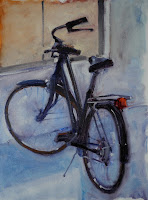An ellipse is just a circle in perspective but when they go in different directions, drawing them can stymie the beginner, and even stump a pro.
Most people can spot drawing errors but the ability to make them right, is something worth knowing.
Start by looking, looking, looking - at wheels, cups, jar lids, soup cans.
An ellipse is a circle (that's 2 dimensional) in perspective, and even if you don't know a thing about perspective, observation and simple rules will guide you.
NO matter what direction a circle is facing, turning, or leaning, - its ellipse will have a directional axis on which it is based. Find the direction and draw the axis lines which will look like a set of cross hairs. Axis lines MUST be perpendicular to each other.
In the example below, see the lines that show the directionality of the shape and the lines that cross it to create the axis of the ellipse.
With these lines in place, draw half of the ellipse on the upper side of the cross hairs and the other half below. It helps to compare the width of your ellipse, top to bottom, to what ever it is you are looking at. Is yours too deep, or too shallow?
The great thing is - a correctly drawn ellipse will be exactly the same in each quadrant. So, if you have drawn one quarter correctly each of the other 3 quarters should be exactly like it, no matter what direction the ellipse is going. Hmmm . . . .
I had a drawing teacher argue with me on this point, saying that because of the foreshortening and perspective most ellipses could never be the same in all 4 quadrants.
We pulled out perspective books, engineering books, and tho' we never read it written anywhere quite this way - in the end he was convinced. NO matter what direction your circular item is facing, turning, or leaning - when drawing ANY ellipse, each quarter will be exactly like the others - just like a circle.
In the example above, drawing the ellipses involved cups going in different directions. The directionality of the each cup is established with one line of the axis that goes in that direction; the line bisecting it is drawn perpendicular to it. From there I drew the ellipses, one quarter at a time.
A final reminder:
An ellipse is made up of arcs and has NO flat edges, or points - just like a circle.


